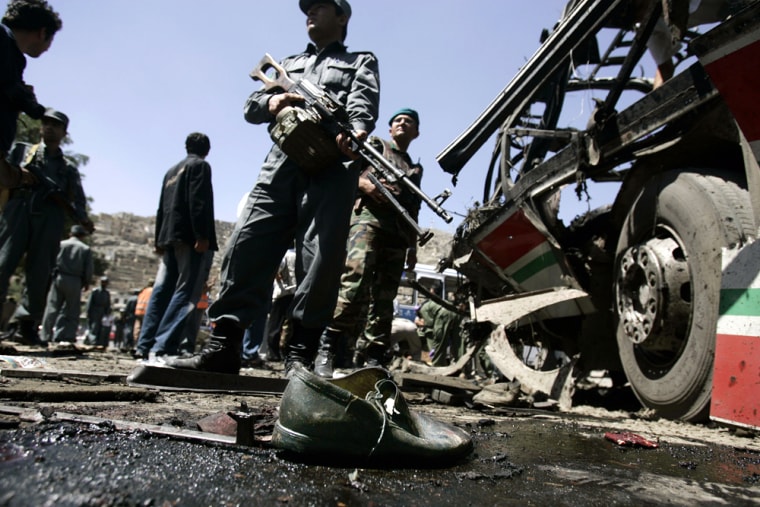An enormous bomb ripped through a police academy bus at Kabul’s busiest transportation hub Sunday, killing at least 35 people in the deadliest insurgent attack in Afghanistan since the U.S.-led invasion in 2001. The Taliban claimed responsibility.
The thunderous explosion in Kabul, which sheared the metal sidings and roof off the bus, leaving only a charred skeleton, represented a leap in scale from previous Taliban or al-Qaida bombings here, raising the specter of an increase in Iraq-style attacks in Afghanistan.
In the country’s south, a roadside explosion killed three soldiers from the U.S.-led coalition and their Afghan interpreter. The brief statement about the blast, in Kandahar province, did not disclose the soldiers’ nationalities. The three deaths bring to 84 the number of U.S. or NATO soldiers killed in Afghanistan this year, including at least 40 Americans.
In the Kabul explosion, at least 35 people were killed, including 22 policemen, said Ahmed Zia Aftali, head of the city’s military hospital. A victim said the bus had been filled with police instructors.
A purported Taliban spokesman, Qari Yousef Ahmadi, said a Taliban suicide bomber named Mullah Asim Abdul Rahman caused the blast. Rahman, 23, was from Kabul province, said Ahmadi, who called an Associated Press reporter by satellite phone from an undisclosed location. His claim could not be verified.
If true, it would be the fifth suicide attack in Afghanistan in three days.
Later, in the country's south, a roadside explosion killed three soldiers from the U.S.-led coalition and their Afghan interpreter. The brief statement about the southern blast did not disclose the soldiers' nationalities. The U.S.-led coalition is comprised of special forces soldiers from several nations; most are American.
Unidentifiable body parts littered the Kabul blast site 30 yards away. Hundreds of police and investigators — with some pulling bodies from the wreckage — ordered civilians to leave the area, an outdoor bus station normally teeming with people.
Bloodied sandals
At a nearby hospital, a large blue plastic trash can overflowed with the bloodied shoes and sandals of victims.
“Never in my life have I heard such a sound,” said Ali Jawad, a 48-year-old selling phone cards nearby. “A big fireball followed. I saw blood and a decapitated man thrown out of the bus. Wounded people were shouting, ’Help me, help me,’ and women and children were shouting and running in different directions.”
Jawad said the blast shocked him into forgetting about his 12-year-old son selling lottery cards nearby.
“I lay under the shadow of a tree when my son came over and asked if I was OK. It was such a shock that I even forgot that my son was there,” he said.
Survivor speaks
At least one person on the bus survived the 8:10 a.m. attack. Nasir Ahmad, 22, was sitting in the back of the bus when the blast went off. He said the bus had been filled with police instructors.
“There were between 30 to 40 police instructors in the bus,” Ahmad said from a hospital bed where he was recovering from wounds to his face and hands.
Despite the Taliban claim, officials were trying to determine if the explosion, which went off in the front of the bus, was caused by a suicide attacker or a bomb that had been planted.
A civilian bus also damaged in the blast was driving just in front of the police vehicle when the blast went off, and a police officer at the scene said the bus’ position likely prevented more civilian casualties.
“Most of the wounded are in serious condition,” said Fazel Rahim, a doctor from a nearby hospital whose hands and white coat were covered in blood. He said at least 35 were injured.
Authorities are frequent targets
Afghan government officials, police and army soldiers are commonly targeted by insurgents trying to bring down the U.S.-backed government of President Hamid Karzai.
A police and army force that can provide security around the country on its own is essential to the U.S. and NATO strategy of handing over security responsibilities to the Afghan government one day, allowing Western forces to leave.
In May, a remote-control bomb hit an Afghan army bus in Kabul, killing the driver and wounding 29 people. In October, a bomb placed on a bicycle exploded as a police bus went by in Kabul, wounding 11. Last July, a remote-controlled bomb blew up near an Afghan army bus in downtown Kabul, wounding 39 people on board.
At least 307 Afghan police, army or intelligence personnel have been killed in violence so far this year through June 15, according to an AP tally of figures from the U.S., U.N., NATO and Afghan authorities.
Worst attack since Taliban's fall
Sunday’s attack is the deadliest by insurgents since the fall of the Taliban. In September 2002, 30 people were killed and 167 wounded in a Kabul car bombing. In February, a suicide bomber detonated explosives himself outside the main U.S. base at Bagram Air Field, killing 23 people, during a visit by Vice President Dick Cheney.
A Pakistani and a Japanese were filming the area before the explosion, so intelligence agents took them for questioning, said Asadullah. Among the wounded were Japanese aid workers passing through the traffic circle, said Koji Miyazaki from the Association for Aid and Relief, Japan.
